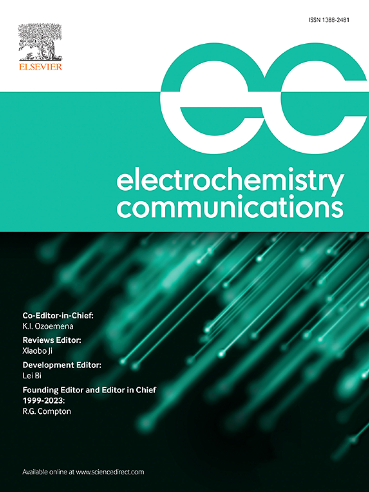One-step atmospheric microplasma synthesis of an NMC-type lithium-ion battery cathode
IF 4.2
3区 工程技术
Q2 ELECTROCHEMISTRY
引用次数: 0
Abstract
The manufacture of battery cathode materials is the most energy-intensive step in the production of commercial lithium-ion batteries; specifically, the synthesis of the widely used transition metal oxide cathodes can require tens of hours at temperatures exceeding 700 °C. Attempts to limit the reaction time and energy required to form crystalline cathode materials often still include a heating or calcination step. This communication aims to highlight a nascent yet novel synthesis route: a one-step atmospheric microplasma process for synthesizing cathode particles in less than one second. The hollow-tube reactor employed produces crystalline particles measuring 0.1–3 μm in diameter, displays narrow XRD peaks corresponding to the 003, 104, and 101 planes, and exhibits anodic redox behavior at 3.75 V vs. lithium—characteristic of transition-metal oxide cathode materials—all without requiring an additional calcination step.
nmc型锂离子电池正极一步大气微等离子体合成
电池正极材料的制造是商用锂离子电池生产中最耗能的一步;具体来说,广泛使用的过渡金属氧化物阴极的合成可能需要在超过700℃的温度下数十小时。试图限制形成结晶阴极材料所需的反应时间和能量,通常仍然包括加热或煅烧步骤。本通讯旨在强调一种新兴但新颖的合成路线:一步大气微等离子体工艺在不到一秒的时间内合成阴极颗粒。所采用的空心管反应器产生直径0.1-3 μm的晶体颗粒,显示对应于003,104和101平面的窄XRD峰,并且在3.75 V vs锂下表现出过渡金属氧化物正极材料的阳极氧化还原行为-所有这些都不需要额外的煅烧步骤。
本文章由计算机程序翻译,如有差异,请以英文原文为准。
求助全文
约1分钟内获得全文
求助全文
来源期刊

Electrochemistry Communications
工程技术-电化学
CiteScore
8.50
自引率
3.70%
发文量
160
审稿时长
1.2 months
期刊介绍:
Electrochemistry Communications is an open access journal providing fast dissemination of short communications, full communications and mini reviews covering the whole field of electrochemistry which merit urgent publication. Short communications are limited to a maximum of 20,000 characters (including spaces) while full communications and mini reviews are limited to 25,000 characters (including spaces). Supplementary information is permitted for full communications and mini reviews but not for short communications. We aim to be the fastest journal in electrochemistry for these types of papers.
 求助内容:
求助内容: 应助结果提醒方式:
应助结果提醒方式:


